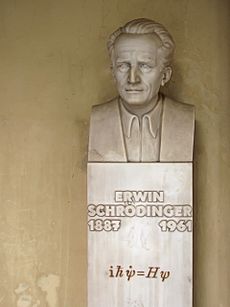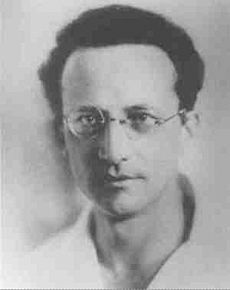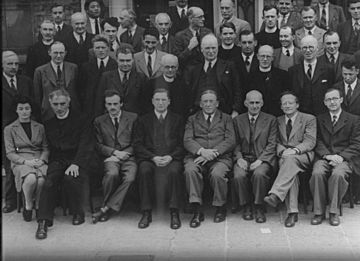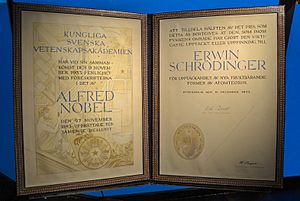Erwin Schrödinger facts for kids
Quick facts for kids
Erwin Schrödinger
|
|
|---|---|

Schrödinger in 1933
|
|
| Born |
Erwin Rudolf Josef Alexander Schrödinger
12 August 1887 |
| Died | 4 January 1961 (aged 73) Vienna, Austria
|
| Nationality | Austrian |
| Citizenship |
|
| Alma mater | University of Vienna (PhD, 1910; Dr. habil., 1914) |
| Known for |
List
Schrödinger equation
Schrödinger's cat Cat state Schrödinger method Schrödinger functional Schrödinger group Schrödinger picture Schrödinger field Rayleigh-Schrödinger perturbation Robertson–Schrödinger uncertainty relations Schrödinger–HJW theorem Schrödinger's pure-affine theory Coherent states Energy level Entropy and life Negentropy Interpretations of quantum mechanics Qualia Quantum biology Quantum entanglement Quantum superposition Quantum steering Zitterbewegung |
| Spouse(s) |
Annemarie Bertel
(m. 1920) |
| Awards | Haitinger Prize (1920) Matteucci Medal (1927) Nobel Prize in Physics (1933) Max Planck Medal (1937) ForMemRS (1949) Erwin Schrödinger Prize (1956) |
| Scientific career | |
| Fields | Physics |
| Institutions |
|
| Thesis | Über die Leitung der Elektrizität auf der Oberfläche von Isolatoren an feuchter Luft (On the conduction of electricity on the surface of insulators in humid air) (1910) |
| Doctoral advisor | Friedrich Hasenöhrl |
| Other academic advisors | Franz S. Exner |
| Signature | |
Erwin Rudolf Josef Alexander Schrödinger (born August 12, 1887 – died January 4, 1961) was a famous Austrian physicist. He won the Nobel Prize in Physics. He is best known for creating the Schrödinger equation. This equation helps us understand how tiny particles, like electrons, behave.
Schrödinger also worked on many other areas of physics. These included statistical mechanics (how large groups of particles act), thermodynamics (heat and energy), and electrodynamics (electricity and magnetism). He was also very interested in philosophy and even wrote about genetics. In popular culture, he is famous for his "Schrödinger's cat" thought experiment.
Schrödinger spent most of his life teaching at different universities. He won the Nobel Prize in 1933 for his work on quantum mechanics. He left Germany that same year because he was against the Nazis. Later, he moved to Dublin, Ireland, where he stayed until he retired. He passed away in Vienna at age 73 from tuberculosis.
Contents
Biography
Erwin Schrödinger's Early Life
Erwin Schrödinger was born in Vienna, Austria, on August 12, 1887. He was the only child of Rudolf Schrödinger and Georgine Emilia Brenda Schrödinger. His mother was part English, and his father was Catholic. His mother was Lutheran.
Even though he grew up in a religious home, he became an atheist. However, he was very interested in Eastern religions and pantheism. He even used religious ideas in his scientific work. He believed his science was a way to understand something divine.
Schrödinger learned English from his British grandmother. From 1906 to 1910, he studied at the University of Vienna. He earned his doctorate there.
Middle Years and Career Changes
In 1914, Schrödinger became a university lecturer. During World War I (1914-1918), he served as an officer in the Austrian army. After the war, he worked at several universities. In 1920, he became an assistant in Jena, Germany. Then, in 1921, he became a full professor in Breslau (now Wrocław, Poland).
Later in 1921, he moved to the University of Zürich. In 1927, he took over from Max Planck at the University of Berlin. In 1933, Schrödinger decided to leave Germany. He strongly disagreed with the Nazis' unfair treatment of Jewish people. He then became a Fellow at Oxford University.
Soon after arriving in Oxford, he won the Nobel Prize with Paul Dirac. His time at Oxford was difficult due to personal life challenges. In 1934, he lectured at Princeton University but did not accept a permanent job there. He then took a position at the University of Graz in Austria in 1936.
Around 1935, after talking a lot with Albert Einstein, he came up with the famous Schrödinger's cat thought experiment.
Later Years and Life in Ireland
In 1938, after the Nazis took over Austria (called the Anschluss), Schrödinger faced problems in Graz. This was because he had left Germany in 1933 and was known to be against the Nazis. He was even told not to leave the country. However, he and his wife managed to escape to Italy. From there, he went to Oxford and Ghent University.
That same year, the leader of Ireland, Éamon de Valera, invited Schrödinger to live in Ireland. De Valera, who was also a mathematician, wanted Schrödinger to help set up an Institute for Advanced Studies in Dublin. Schrödinger moved to Dublin and lived there for 17 years. He became an Irish citizen in 1948 but also kept his Austrian citizenship.
In 1944, he wrote a famous book called What Is Life?. In this book, he discussed how living things store their genetic information in complex molecules. This book inspired scientists like James Watson and Francis Crick. Their research later led to the discovery of the DNA double helix structure in 1953.
Schrödinger retired in 1955 and returned to Vienna in 1956. He passed away on January 4, 1961, at the age of 73, due to tuberculosis. He was buried in a Catholic cemetery in Alpbach, Austria.
Academic Interests and Discoveries
Early Scientific Work
When he was younger, Schrödinger experimented with electrical engineering and atmospheric electricity. He also studied how molecules vibrate and how tiny particles move randomly (called Brownian motion). In 1912, he wrote an article about dielectrics, which are materials that don't conduct electricity well.
He also calculated how radioactive substances are spread out in the atmosphere. In 1913, his experiments confirmed his calculations. For this work, he received the Haitinger Prize in 1920. After 1919, Schrödinger focused mostly on theoretical studies.
Quantum Mechanics and the Wave Equation
Understanding Quantum Theory
Early in his career, Schrödinger learned about the ideas of quantum theory. This theory was developed by scientists like Max Planck and Albert Einstein. At first, Schrödinger preferred traditional physics.
However, in the 1920s, he started publishing articles about atomic theory and spectra. He was especially interested in how relativity fit into quantum theory. In 1922, he looked at how electrons orbit in an atom using geometry. This work helped him predict some features of wave mechanics.
Creating Wave Mechanics
In January 1926, Schrödinger published a groundbreaking paper. It introduced what is now known as the Schrödinger equation. This equation describes how the "wave function" of a system changes over time. The wave function tells us about the probability of finding a particle in a certain place. This paper was a huge achievement and changed how we understand quantum mechanics.
He published more papers soon after, showing how his new approach worked for different problems. He also showed that his ideas were similar to those of Werner Heisenberg. Schrödinger called his theory "wave mechanics."
Schrödinger was not completely happy with some ideas in quantum theory. He didn't like the idea of probability being so central. To show how strange some of these ideas were, he created the famous Schrödinger's cat thought experiment.
Search for a Unified Theory
After his work on quantum mechanics, Schrödinger spent a lot of time trying to find a unified field theory. This theory would combine gravity, electromagnetism, and nuclear forces. He worked closely with Albert Einstein on this. However, his attempts did not lead to the unified theory he hoped for.
Interest in Color and Philosophy
Schrödinger was very interested in how we see colors. He spent several years studying this and published many papers on the topic. His work followed in the footsteps of famous scientists like Isaac Newton and James Clerk Maxwell.
He also had a deep interest in philosophy. He was influenced by thinkers like Arthur Schopenhauer. Schrödinger often thought about consciousness, the mind-body problem, and free will. He believed that consciousness could not be explained by just physical terms. He also explored ideas from Indian philosophy.
Legacy
Schrödinger's cat is still discussed today and is his most famous idea in popular science. The Schrödinger equation is his most important scientific contribution. Schrödinger is considered one of the "father of quantum mechanics".
A large crater on the far side of the Moon is named Schrödinger after him. The Erwin Schrödinger International Institute for Mathematical Physics was also created in Vienna in 1993.
His picture was on the 1000-schilling banknote in Austria from 1983 to 1997. A building at the University of Limerick in Ireland and a lecture hall at Trinity College Dublin are also named after him. In 2013, Google Doodle celebrated his 126th birthday.
Honors and Awards
- Haitinger Prize (1920)
- Matteucci Medal (1927)
- Nobel Prize in Physics (1933) – shared with Paul Dirac
- Max Planck Medal (1937)
- Elected a Foreign Member of the Royal Society (1949)
- Erwin Schrödinger Prize (1956)
- Austrian Decoration for Science and Art (1957)
Published Works
- The List of Erwin Schrödinger's publications
- Science and the human temperament (1935)
- Nature and the Greeks and Science and Humanism (1996)
- The interpretation of Quantum Mechanics (1995)
- Statistical Thermodynamics (1989)
- Collected papers (1984)
- My View of the World (1983)
- Expanding Universes (1956)
- Space-Time Structure (1950)
- What Is Life? (1944)
- What Is Life? & Mind and Matter (1974)
Images for kids
See also
 In Spanish: Erwin Schrödinger para niños
In Spanish: Erwin Schrödinger para niños






